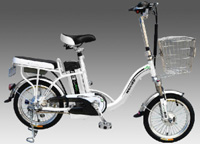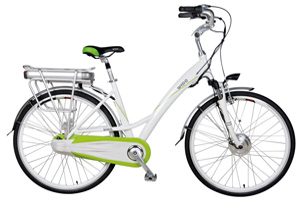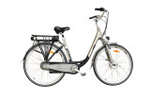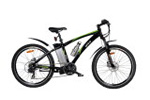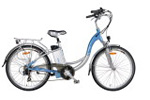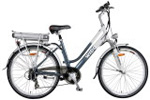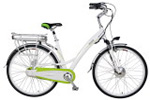| An electric bicycle, also known as an e-bike, is a bicycle with an integrated electric motor which can be used for propulsion. There are a great variety of different types of e-bikes available worldwide, from e-bikes that only have a small motor to assist the rider's pedal-power (i.e. pedelecs) to somewhat more powerful e-bikes which tend closer to moped-style functionality: all however retain the ability to be pedalled by the rider and are therefore not electric motorcycles. E-bikes use rechargeable batteries and the lighter varieties can travel up to 25 to 32 km/h (16 to 20 mph), depending on the laws of the country in which they are sold, while the more high-powered varieties can often do in excess of 45 km/h (28 mph).【More】 |
| In the 1890s, electric bicycles were documented within various U.S. patents. For example, on 31 December 1895, Ogden Bolton Jr. was granted U.S. Patent 552,271 for a battery-powered bicycle with "6-pole brush-and-commutator direct current (DC) hub motor mounted in the rear wheel." There were no gears and the motor could draw up to 100 amperes (A) from a 10-volt battery. Two years later, in 1897, Hosea W. Libbey of Boston invented an electric bicycle (U.S. Patent 596,272) that was propelled by a "double electric motor." The motor was designed within the hub of the crankset axle.[5] This model was later re-invented and imitated in the late 1990s by Giant Lafree e-bikes. |
| E-bikes with pedal-assist only. These are either pedelecs (legally classed as bicycles) or S-Pedelecs (legally classed as moped or motorcycles) | |
| Pedelecs : Have pedal-assist only; motor assists only up to a decent but not excessive speed (usually 25 km/h) ; motor power up to 250 Watts. Pedelecs are often legally classed as bicycles. | |
| S-Pedelecs : Have pedal-assist only; motor power can be greater than 250 Watts; can attain a higher speed (e.g. 45 km/h) before motor stops assisting. Legally classed as a moped or motorcycle not a bicycle. | |
| E-bikes with power-on-demand and pedal-assist.Some e-bikes combine both pedal-assist sensors as well as a throttle. | |
| E-bikes with power-on-demand only. These often have more powerful motors than pedelecs but not always. The more powerful of these are legally classed as mopeds or motorcycles. |
Market Predictions of Electric Bicycle
E-bike usage worldwide has experienced rapid growth since 1998. It is estimated that there were roughly 120 million e-bikes in China as of early 2010, and sales are expanding rapidly in India, the United States of America, the Netherlands, and Switzerland. A total of 700,000 e-bikes were sold in Europe in 2010, up from 200,000 in 2007 and 500,000 units in 2009.
Today, China is the world's leading producer of e-bikes. According to the data of the China Bicycle Association, a government-chartered industry group, in 2004 China's manufacturers sold 7.5 million e-bikes nationwide, which was almost twice the year 2003 sales; domestic sales reached 10 million in 2005, and 16 to 18 million in 2006.
PikeResearch, a for-profit market research firm, released a report in 2010 which included market analysis and forecasts for electric two-wheel vehicles. They conclude that, "The worldwide electric two-wheel vehicle market is expected to grow at a compound annual rate of 9% through 2016" and that "a lack of a well-defined retail channel hampers faster adoption in North America and Europe." PikeResearch also forecasted that worldwide sales of e-bikes, e-motorcycles, and e-scooters will reach more than 466 million between 2010 to 2016, and China will continue to dominate the world market, with more than 95% of sales during this period. E-bikes sales are expected to have the largest share with 56% of the market.
However, the Los Angeles Times reported that e-bike sales in the U.S. have slowed in 2010 compared to 2009. This could be due to a slowing economy."
The Development Experience of Electric Bicycle in Main Coutries click picture for details
Further reading
Legal Status of Electric Bicycle in Different Countries
Written by Dora Men

